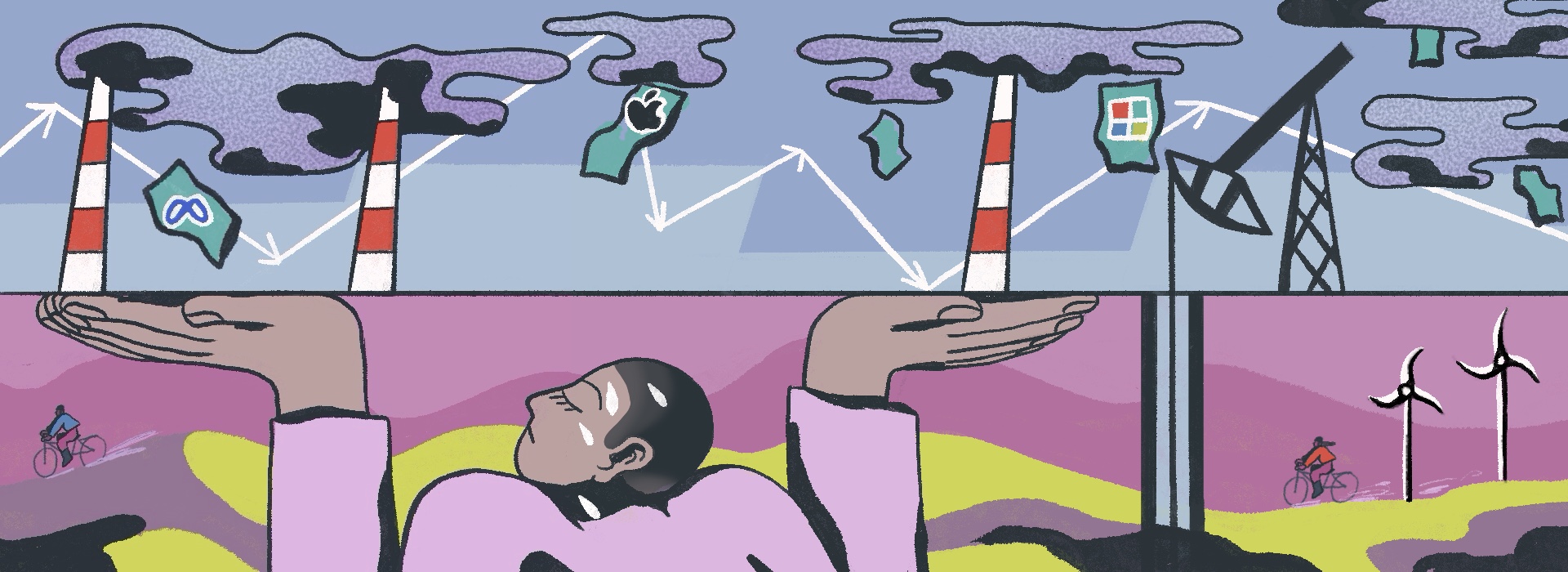Last October, California Governor Gavin Newsom signed three landmark climate disclosure bills, mandating over 10,000 US companies to fully disclose carbon emissions across their value chains.
Against the backdrop of increasing wildfires, unbearable heatwaves, and tropical storms across the state, heavier carbon regulation is obviously needed. However, this bill was hard won. A coalition of corporations reportedly spent more than $7 million lobbying to dilute and halt the bill.
But why are they so pressed? Most of the companies fighting the bill have already set “net-zero commitments” to drastically cut their carbon emissions. The new bill doesn’t even require companies to reduce their emissions – just to calculate and disclose them.
The answer lies in the existing regulation and monitoring being beset with fuzzy definitions and loopholes, which corporations are gleefully exploiting.
While oil and gas companies vocally oppose such regulations, tech companies often escape scrutiny. Researchers estimate the tech sector produced between 2-3% of the world’s carbon emissions in 2021, comparable to global aviation and larger than Japan, the fifth biggest polluter. These companies frequently underreport and camouflage their supply chain emissions, making stringent monitoring and disclosure a significant threat.
Understanding carbon accounting
Carbon accounting can seem a bit dry to those of us who understand the drastic changes needed to combat the climate crisis – but it is important when we remember just 100 companies are responsible for 70% of the world’s industrial GHG emissions. For us to comprehensively assess their climate impact, we need corporations to measure and publicly report not only the emissions caused by their own operations, but also from the raw materials they source and use of the goods they sell.
Originating in the 1990s, carbon accounting is the process of measuring and reporting an organisation’s greenhouse gas emissions. Dr Joe Blakey, an environmental and political geographer at the University of Manchester, explains its roots to me when we chatted over zoom: “The Kyoto Protocol in 1997 first set out how states should monitor and report their carbon emissions, which later evolved into the corporate social responsibility agenda and suddenly we see everyone reporting their carbon footprints.”
The Greenhouse Gas Protocol has become the global standard for emissions reporting. This process involves quantifying emissions across three scopes:
- Scope 1: Direct emissions from owned or controlled sources (e.g. gas produced by onsite heating)
- Scope 2: Indirect emissions from purchased electricity, steam, heating, and cooling
- Scope 3: All other indirect emissions occurring in a company’s value chain (outsourced manufacturing emissions, transportation emissions, waste disposal etc.)
The tech sector’s challenges become apparent with Scope 3, encompassing emissions from manufacturing, transportation, and product usage. For example, an iPhone’s carbon footprint should include raw material extraction, production, shipping and disposal – all far more carbon-intensive than operating Apple Stores.
Gavin Newsom’s Climate Disclosure Accountability Act requires companies with over $1 billion in revenue to disclose their Scope 3 emissions by 2027, to tackle current scope 3 weak reporting systems.
The oft-forgotten data centre
A study by the New Climate Institute exposes that many major tech companies are not only failing to meet their own targets but exploiting loopholes to exaggerate their progress.
Billionaire Bill Gates, who penned How to Avoid a Climate Disaster: The Solutions We Have and the Breakthroughs We Need in 2021, has ironically seen Microsoft’s emissions soar by a near 30% since 2020. In 2023, The Verge reviewed dozens of emissions reports from Microsoft suppliers and found some who still power their entire operations with fossil fuels. Further, Microsoft’s rapid construction of new data centres for AI and cloud computing is energy intensive, as they race against competitors to capitalise on growing interests in AI.
Competitor Meta is way off achieving its net-zero goal, with only 1% of its emissions in Scope 1 and 2, leaving 8.5 million tonnes of CO2 equivalent in supply chain emissions. Again, data centres are a huge portion of this and are only predicted to grow as our demand for digital infrastructure increases and these companies strive to dominate the digital space.
These emissions partly come from the extraction and processing of critical construction materials for hardware such as cement and steel that are carbon-intensive to produce. The Cloud now has a greater carbon footprint than the airline industry, with data centres consuming as much electricity as 50,000 homes – collectively devouring more energy than some nation states.
Fudging the numbers
In 2019, Jeff Bezos said he was “done being in the middle of the herd” on climate policies when launching Amazon’s Climate Pledge to use 100% renewable energy by 2030. He announced this just a day before 1,500 Amazon employees planned to walk out of work to join a wave of global climate strikes. Two of the leading agitators from Amazon Employees for Climate Justice were then fired in what the US National Labor Relations Board determined was illegal retaliation, leading to a settlement last year.
Under pressure from activists, thousands of companies disclose their carbon footprints to a nonprofit organisation called the Carbon Disclosure Project (CDP). Until 2021, Amazon had refused to do so, and when it submitted for the first time, it refused to share the report publicly.
Amazon positions itself as a climate leader and reports an absolutely tiny carbon footprint compared to its competitors. Target, whose accounts are public, showed triple the amount of emissions Amazon did, despite Amazon racking up well over $100 billion more in sales. How is this possible?
Well, they’ve made their own rules. Amazon only takes responsibility for products with an Amazon brand label, which make up 1% of its online sales. Products made by other companies Amazon simply ignores, unlike its peers Target or Walmart.
Amazon Workers for Climate Justice conducted their own internal research, revealing that the company removed its goal to make half of shipments net-zero by 2030 and deleted the original blog post announcing it. They’re not afraid to quietly remove the targets they’re failing to meet.
Again, the lack of clarity around reporting emissions from supply chains allows Amazon to dodge accountability and mask the majority of its dirty supply chains. Are we noticing a pattern here? The investigation shows how tech companies can capitalise on a green, clean and progressive image by faking numbers and dismantling employee pressure, highlighting the pitfalls on self-disclosures and voluntary commitments.

Join our mailing list
Sign up for shado's picks of the week! Dropping in your inbox every Friday, we share news from inside shado + out, plus job listings, event recommendations and actions ✊
Sign up for shado's picks of the week! Dropping in your inbox every Friday, we share news from inside shado + out, plus job listings, event recommendations and actions ✊
If Amazon accounted properly, it would need to eliminate tens of millions more tons of carbon emissions – requiring a radical transformation of its operations and forcing its suppliers to do the same.
Yet even with the lies… its reported carbon footprint still increased by over 35% from 2018 to 2020.
Is accounting effective?
Dr. Joe suggests the system is primed to be exploited, as it is a “quite peculiar and very western” way of measuring a climate system. “I personally would make the argument that the world out there is kaleidoscopic – there are so many pictures of accountability you could take.”
He outlines the difficulties of say, carbon accounting for someone in the UK eating lamb reared in New Zealand. Think of the emissions bound up in the energy supplied to the farm to rear the land, the distributor transporting it overseas, the supermarket using energy cooling the fridge to store it in, the consumer driving it home, the running of the sewage plant where the waste is disposed. “You could tie that all to an individual consumer, but you could also ask who invested in that farm?” he tells me. “Is it the person who gets the money from this process accountable? Who is responsible for the transport emissions?”
“There are so many ways of cutting the carbon cake, and these tools are useful but they only give you one sense of an interconnected system.” And this can be taken advantage of.
Throw the baby out?
With all these dodgy accounting methods, it would be easy to say: carbon accounting doesn’t work. But let’s not throw the baby out with the bathwater.
Understanding the carbon footprint of countries and companies is fundamental to outlining the necessary paths to a sustainable society, one that exposes the need for radical change to business practices and not just a reformed business-as-usual approach.
Carbon accounting allows us to visualise stark global inequalities, the inequity of corporations and countries profiting off pumping endless carbon into the air, and the disproportionate burden of climate change borne by marginalised and vulnerable communities.
Farhana Sultana, an interdisciplinary scholar in climate justice, said to the Guardian: “Carbon inequality is effectively a colonisation of the atmosphere by the capitalist elite of the planet through hyper-consumption and pollution, while the cost of that climate coloniality is borne disproportionately by the marginalised and vulnerable communities in developing countries.”
To expose these inequalities and embed the necessary regulation to force corporations to change, we need data. When we have the numbers, it is easy to see the correlation between those hoarding wealth and power and their role as engines of the climate crisis. We already know this from decades of climate and environmental justice organisers on the ground in the Global South, but these accounts paired with data and water tight regulation, exposes their climate harmful practices to legal action.
Litigation is emerging as one key tactic to force corporations to act. Since 2015, about 230 climate-aligned lawsuits have been filed against corporations and trade associations, with two-thirds initiated since 2020. A growing number of these lawsuits target “climate-washing,” where companies misrepresent their progress towards environmental targets. In 2023 alone, 47 climate-washing cases were filed.
Of the 140 climate-washing cases reviewed between 2016 and 2023, 77 are concluded and 54 ruled in favour of the claimant. And these litigators need data. And for good data we need regulation, we need transparency, we need ambition.
It’s not perfect
Carbon accounting is not without its criticisms. Dr Joe Blakey warns: “Accounting is not always conducted purely in the service of the climate.” He emphasises that these tools, while useful, can be value-laden and sometimes silence critical voices.
Getting people to report their emissions is not enough, it has to be a force to drive actual action. Therefore, alongside these tools must come sharp regulation to prevent complacency and ensure transparency. The panic and cash poured into fighting California’s bill show that well-regulated carbon accounting processes expose the lies at the heart of so-called corporate climate action.
As carbon accounting becomes democratised through legislation, it empowers more people to understand and influence climate action. Holding tech companies to account is hard, and activists, litigators and pressure groups need accurate data. With the right regulation, carbon accounting can be one of the many tools in our box to expose the inequalities fueling the climate crisis and drive necessary change in the tech industry.
What can you do?
- Follow and support Client Earth, who are ambitiously taking on polluting industries through litigation
- Check out Amazon Employees for Climate Justice, a grassroots worker-led pressure group forcing Amazon to attention. If you are or know an employee of Amazon, fill in this survey to support action and show support from other workers – and share it around!
- If you are interested in workers exposing what is going on behind the scenes at these tech companies, check out the report they wrote: Burns Trust: The Amazon Unsustainability Report
- Get support from a company specialising in carbon accounting, such as GoClimate – who works with 100% transparency and always has climate justice in mind
- Follow Joycelyn Longdon award-winning environmental justice technologist, writer + educator, exposing the environmental harms of the tech industry and calling on them to clean up their act
- Read more articles in our Can Tech column:





